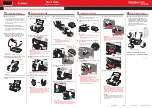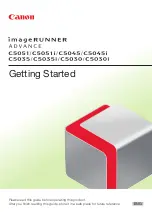
6. Reference Information
IEEE
The Institute of Electrical and Electronics Engineers (IEEE) is an international non-profit, professional
organization for the advancement of technology related to electricity.
IEEE 1284
The 1284 parallel port standard was developed by the Institute of Electrical and Electronics Engineers
(IEEE). The term "1284-B" refers to a specific connector type on the end of the parallel cable that
attaches to the peripheral (for example, a printer).
Intranet
A private network that uses Internet Protocols, network connectivity, and possibly the public
telecommunication system to securely share part of an organization's information or operations with
its employees. Sometimes the term refers only to the most visible service, the internal website.
IP address
An Internet Protocol (IP) address is a unique number that devices use in order to identify and
communicate with each other on a network utilizing the Internet Protocol standard.
IPM
The Images Per Minute (IPM) is a way of measuring the speed of a printer. An IPM rate indicates the
number of single-sided sheets a printer can complete within one minute.
IPP
The Internet Printing Protocol (IPP) defines a standard protocol for printing as well as managing print
jobs, media size, resolution, and so forth. IPP can be used locally or over the Internet to hundreds
of printers, and also supports access control, authentication, and encryption, making it a much more
capable and secure printing solution than older ones.
IPX/SPX
IPX/SPX stands for Internet Packet Exchange/Sequenced Packet Exchange. It is a networking
protocol used by the Novell NetWare operating systems. IPX and SPX both provide connection
services similar to TCP/IP, with the IPX protocol having similarities to IP, and SPX having similarities
to TCP. IPX/SPX was primarily designed for local area networks (LANs), and is a very efficient
protocol for this purpose (typically its performance exceeds that of TCP/IP on a LAN).
ISO
The International Organization for Standardization (ISO) is an international standard-setting body
composed of representatives from national standards bodies. It produces world-wide industrial and
commercial standards.
ITU-T
The International Telecommunication Union is an international organization established to standardize
and regulate international radio and telecommunications. Its main tasks include standardization,
allocation of the radio spectrum, and organizing interconnection arrangements between different
countries to allow international phone calls. A -T out of ITU-T indicates telecommunication.
ITU-T No. 1 chart
Standardized test chart published by ITU-T for document facsimile transmissions.
JBIG
Joint Bi-level Image Experts Group (JBIG) is an image compression standard with no loss of accuracy
or quality, which was designed for compression of binary images, particularly for faxes, but can
also be used on other images.
JPEG
Joint Photographic Experts Group (JPEG) is a most commonly used standard method of lossy
compression for photographic images. It is the format used for storing and transmitting photographs
on the World Wide Web.
LDAP
The Lightweight Directory Access Protocol (LDAP) is a networking protocol for querying and
modifying directory services running over TCP/IP.
LED
A Light-Emitting Diode (LED) is a semiconductor device that indicates the status of a machine.
MAC address
Media Access Control (MAC) address is a unique identifier associated with a network adapter. MAC
address is a unique 48-bit identifier usually written as 12 hexadecimal characters grouped in pairs (e.
g., 00-00-0c-34-11-4e). This address is usually hard-coded into a Network Interface Card (NIC) by its
manufacturer, and used as an aid for routers trying to locate machines on large networks.
MFP
Multi Function Peripheral (MFP) is an office machine that includes the following functionality in one
physical body, so as to have a printer, a copier, a fax, a scanner and etc.
MH
Modified Huffman (MH) is a compression method for decreasing the amount of data that needs to be
transmitted between the fax machines to transfer the image recommended by ITU-T T.4. MH is a
codebook-based run-length encoding scheme optimized to efficiently compress white space. As most
faxes consist mostly of white space, this minimizes the transmission time of most faxes.
MMR
Modified Modified READ (MMR) is a compression method recommended by ITU-T T.6.
6-5
Copyright© 1995-2016 SAMSUNG. All rights reserved.








































